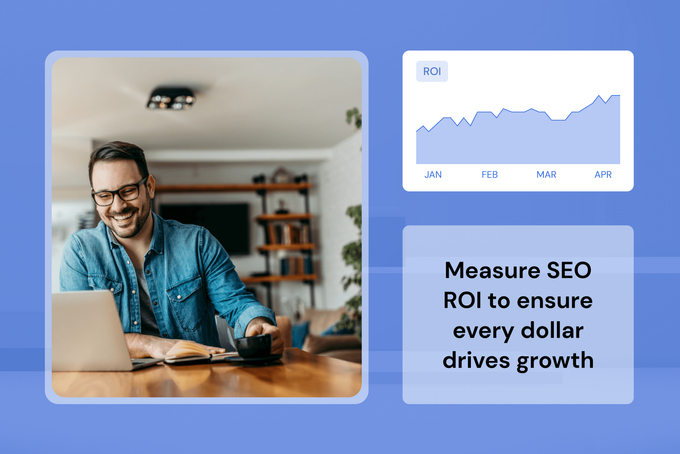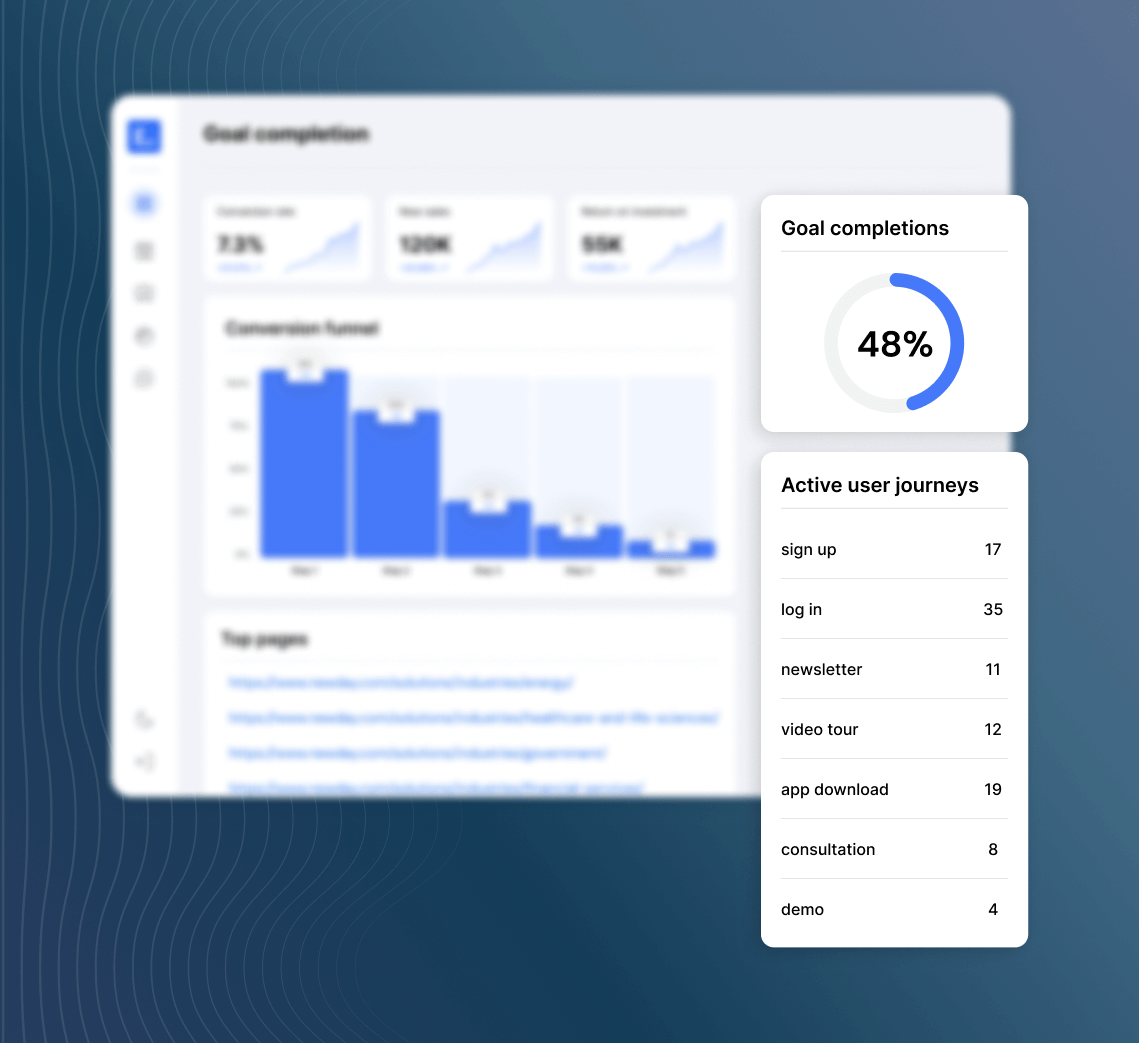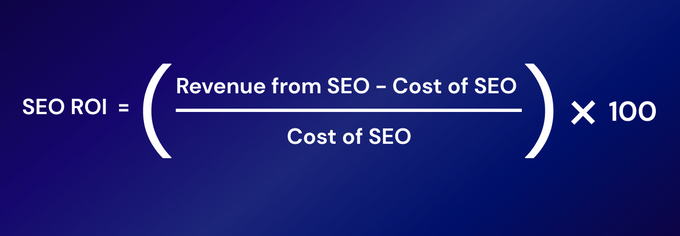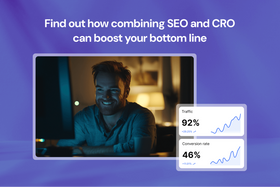SEO ROI: How to measure success (with formulas & examples)
Learn to track, measure, and forecast SEO ROI to find out if your SEO efforts are really paying off.
Updated February 19, 2025

Measuring return on investment (ROI) is crucial for any business investing in SEO. Stakeholders need proof that the resources allocated to SEO generate a positive return, and businesses need to understand if they're profitable or not. Knowing your SEO ROI also helps you make data-driven decisions—whether to invest more, scale back, or refine your strategy.
While it's clear why measuring SEO ROI is important, the actual process can be challenging. In this article, I'll show you how to measure SEO ROI in a meaningful way, but let's go over the basics first.
Key takeaways
- SEO ROI is the revenue generated from SEO in comparison to the cost.
- You need to have enough traffic in order to measure SEO ROI, which usually takes 6-12 months.
- At the end of the day, revenue per visitor is one of the most important metrics to measure and optimize.
- There are specific nuances and challenges to keep in mind when measuring SEO ROI.
What is SEO ROI?
SEO ROI refers to the revenue your SEO efforts generate compared to how much you spend on them. Calculating SEO ROI gives you a clear picture of how effective your SEO strategy is and whether your efforts are profitable or need adjusting.
The formula to calculate SEO ROI is pretty straightforward:
For example, if your revenue from SEO is $7,000 and the cost of your SEO efforts is $3,000, your SEO ROI would be 133%. This means that for every dollar you spend on SEO, you earn $1.33 in profit.
Unfortunately, calculating SEO ROI is hardly ever this simple. Yes, this formula tells you if your overall SEO efforts are profitable, but it's just an average. If you want to optimize and grow, you need to dig deeper into which specific pages contribute to your bottom line—and how much they contribute.
How to measure SEO ROI
SEO takes time, so you can't measure ROI until your website has enough traffic. But you should track all the necessary data from the beginning. Then, start measuring SEO ROI once you have significant traffic, which can easily take six to twelve months.
Here's how you can measure ROI for SEO once you reach that level.
» Learn how to measure SEO conversions.
1. Understand the different types of organic traffic
To measure SEO ROI effectively, you need to understand the types of traffic you get from search. This traffic falls into three main categories:
- Branded traffic: Searches using your brand name—for example, "Nike" or "Wix." In my opinion, you shouldn't account for branded traffic when measuring SEO ROI, as it's driven by any activity that creates brand awareness and not just SEO.
- Product searches: Non-branded queries that represent exactly what you're doing, like "running shoes" for Nike or "website builder" for Wix. These are highly competitive and often dominated by ads, making it very difficult to rank.
- Informational searches: The largest traffic source where users seek information related to your products or services. For example, they may search "how to choose the right running shoes" or "how to create a website for free." This category offers the most potential for SEO and can lead to conversions.
» Discover how to drive organic traffic and increase SEO ROI in the process.
2. Account for attribution
When measuring SEO ROI, you have to account for attribution—specifically, what counts as an SEO-attributed sale. For example, if a user lands on an article like "Best shoes for long-distance runners" and then buys running shoes, that sale can be attributed to SEO. However, attribution becomes a bit more complex if the user comes from another channel, like social media, then reads an article, and eventually makes a purchase. In this case, the content acts as an assist rather than a direct conversion point.
» Learn about attribution windows and how they impact conversions.
Attribution can be broken down into three main types:
- First touch: A content page is the first interaction the user has with your brand.
- Assist: A content page helps guide the user toward a purchase.
- Last touch: The final interaction before conversion involves SEO content.
» Learn to optimize complex user journeys for conversion with multi-touch attribution.
To create a scalable SEO operation, you need a lot of content, and it's important to track its impact, whether it's the first touch, assist, or last touch in the user journey. Often, users will interact with multiple pages before converting, so you need to allocate value across all those touchpoints to get a clear picture of how SEO contributes to ROI.
3. Track how content drives users through your funnel
When it comes to SEO, content is most of the work. Content attracts traffic from various sources, so you need to measure the direct contribution of your content to your sales funnel. This involves tracking whether users start with, engage with, or complete their journey on a content page.
Content also influences your rankings. For example, if a user searches for a website builder and Wix ranks above WordPress or Shopify, it's heavily influenced by the content that demonstrates Wix's expertise. Google uses content as a key signal to understand a site's topical authority. Many top brands rank highly because of the amount of content they create and not just their products.
When calculating SEO ROI, it's important to account for all your content activities. Measure how much traffic flows through your content on the path to purchase.
» Learn how to improve content marketing ROI.
4. Measure revenue per user
Another key SEO metric to track is revenue per visitor. This would be the metric you want to optimize because it directly reflects how well your pages perform. Unlike paid traffic, you can't control how much traffic you get from SEO since it's determined by the algorithm. That's why you should focus on how many visitors each page receives and how much revenue it generates. Tracking revenue per visitor helps you understand the true impact of each page on your bottom line.
» See which SEO KPIs you should be tracking in 2026.
The formula SEO for calculating RPV looks like this:
Your goal should be to increase both traffic and conversions to boost revenue per visitor. While total revenue from SEO is important, revenue per visitor gives you a clear picture of how efficiently your content is driving sales and where you can make improvements.
» Discover proven techniques to improve SEO ROI.
How to forecast ROI for SEO
Despite what some may say, forecasting SEO ROI is possible. At its core, SEO is quite simple: you want to target specific keywords and rank for them. The higher you rank, the better your click-through rate (CTR) on Google and the more traffic you get. When you target keywords at the bottom of the funnel, the conversion rate is going to be higher because they capture users with strong buying intent. Targeting upper-funnel keywords leads to lower conversion rates as they attract users looking for information rather than making a purchase.
So, to forecast the ROI of SEO, you need to look at:
- The relevance of your target keywords
- Their position in the funnel
- Search volume
- Competition
- The value of your product
- Conversion potential
Understanding and mapping these factors can help you estimate where you might rank, the traffic you could generate, and how much money you can make per visitor. This is exactly what Entail strategy does. It maps out all the keywords that you want to target with the data listed above. From there, you can forecast how much money you're going to make from SEO.
» Get a content strategy designed to convert. Contact us for a private demo.
Key challenges of measuring SEO ROI
Attributing conversions to SEO
One of the main challenges in measuring SEO ROI is accurate attribution, which is essential because traffic comes from various sources—not just SEO. Without proper attribution, it's nearly impossible to determine the true impact of your SEO efforts.
Most companies approach this in one of three ways:
- Not measuring: Some businesses simply don't measure SEO ROI because it's too difficult, or they're doing SEO simply because they believe that's what they should do.
- Measuring too broadly: Other companies might look at their overall organic traffic and revenue and calculate ROI at a broad level without understanding exactly where their sales come from.
- Leveraging advanced analytics: Large companies use business intelligence (BI) tools like Tableau to create complex reports that track clicks and user journeys, but this requires significant resources and expertise, and even these processes often fall short.
Entail's goal attribution model offers a solution to this challenge by accurately measuring the impact of SEO across different pages and channels. Unlike standard analytics tools that can't pinpoint which content drives conversions, Entail CRO shows you where your traffic comes from and how much value each page generates for you. It provides a clearer picture of how your SEO efforts contribute to revenue without needing a complex and resource-intensive setup—just one comprehensive SEO ROI tool.
» Discover whether SEO ROI can always be measured.
Measuring branded vs. non-branded traffic
When measuring SEO ROI, you have to distinguish between branded and non-branded traffic. I would argue that branded traffic is more a reflection of your branding efforts than SEO, even though it appears in search results. This additional nuance can make it difficult to attribute conversions solely to SEO.
Optimizing user journeys
Websites that get a lot of organic traffic usually have hundreds or even thousands of pages, especially when creating content at scale. Each page may contain 30 to 50 links, resulting in a huge number of possible user journeys. This makes it nearly impossible to track and optimize individual user journeys to determine which interactions lead to conversions.
But Entail CRO measures the value each page contributes and optimizes at the page level to improve performance. That way, you don't need to tackle the chaos of fragmented user behavior that other analytics tools can't manage.
Track, measure, and maximize SEO ROI
Understanding SEO ROI allows you to see the direct impact of your efforts and identify areas of growth. If you find that your SEO strategy is yielding a strong ROI, you can confidently increase your budget, expand your activities, and create more content. On the flip side, it helps you decide where to cut back and reallocate resources to areas with better potential. Ultimately, measuring SEO ROI is about making informed decisions that drive your business forward.
» Book a demo to see Entail CRO in action, or try it for free.







